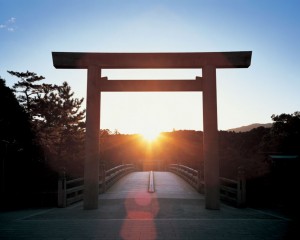Why do Japanese like to visit shrines? 2015/01/24
The number of yearly visitors to Ise grand shrine which enshrines Amaterasu, the founder of Imperial family, has been over ten millions in recent years. It reached to 14 millions in 2013 when the traditional big ceremony of regular renewal of the shrine in every 20 years was performed beautifully and solemnly.
It has been popular among Japanese to visit Ise grand shrine for couple hundred years except a certain period just after the world war second when the occupation troops put pressure on Japanese not to believe in Shintoism or visit shrines.
During Edo period, more than 3 million people visited Ise grand shrine yearly. It was unbelievably big number when we consider the condition of traffic ( Ise locates over 400 km west of Edo), total population (30 million) at that time.
Izumo grand shrine which enshrines popular Okuninushi also enjoys the increase of visitors. The number of yearly visitors reached to 8 million in 2013 when they performed the traditional regular renewal in every 60 years (different frequency from Ise grand shrine).
There are around 100 thousand shrines in Japan including such grand shrines to small and quiet shrines. Until the end of Muromachi period (nearly 500 years ago), most villages managed to build their own shrines. Basically there are two types of such shrine, one enshrines ujigami (the ancestor of the family) and the other enshrines ubusanagami (the guardian of the district). They call such a village shrine as “chinnjusama” which means the guardian.
Village people tend to gather at the village shrine at various occasions such as New Year Day or seasonal festivals and so on. Moreover many worshippers visit shrines everyday and the garden of shrines are the best places for children to play. The shrine has been the center of village for many years.








